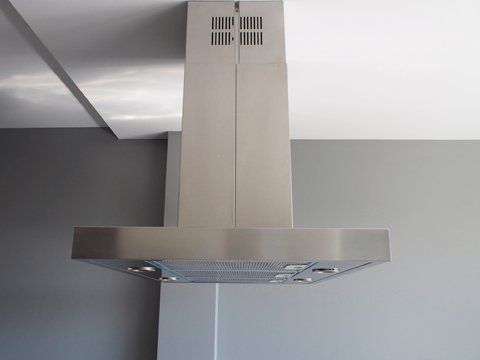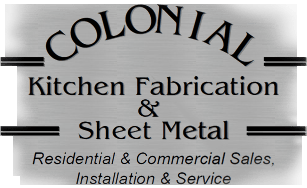3 Important Reasons to Install a Custom Kitchen Hood
- By Admin
- •
- 24 May, 2018

Twenty years ago or so, it was rare to walk into a home that didn't have a microwave in place over the stove. Although range-hood microwaves were an easy way to keep kids from playing with a potentially dangerous appliance, these out-of-the-way gadgets also took up valuable space where a custom fume hood could go.
These days, more and more people are opting for kitchen exhaust hoods, and here are a few reasons why.
These days, more and more people are opting for kitchen exhaust hoods, and here are a few reasons why.
1. Professional and Polished Kitchens
Because foodies around the globe want functional, gorgeous kitchens, custom kitchen hoods are a natural choice. Placed directly over cooking surfaces, exhaust hoods are fitted with powerful fans that help to remove heat and smoke from kitchens, while making the area look like it is fit for a professional chef.
Custom sheet-metal manufacturing companies can create special fume hood covers to match your cabinetry or kitchen hardware. For instance, if you have birch cabinets accented with brushed nickel hardware, a stainless steel fume hood can be custom fitted to the area above your stove, creating a seamless appearance and a functional workspace.
Exhaust hoods can be made in a wide range of shapes and sizes, including versions with covers that are paintable. Manufacturers can even add special features to make your space even more functional, such as extra lighting or remote-mounted fans. Exterior panels are typically made from zinc, stainless steel, or copper since metals aren't susceptible to heat damage.
Custom sheet-metal manufacturing companies can create special fume hood covers to match your cabinetry or kitchen hardware. For instance, if you have birch cabinets accented with brushed nickel hardware, a stainless steel fume hood can be custom fitted to the area above your stove, creating a seamless appearance and a functional workspace.
Exhaust hoods can be made in a wide range of shapes and sizes, including versions with covers that are paintable. Manufacturers can even add special features to make your space even more functional, such as extra lighting or remote-mounted fans. Exterior panels are typically made from zinc, stainless steel, or copper since metals aren't susceptible to heat damage.
2. Better Indoor Air Quality
Although most people figure indoor air is cleaner than the air outside, the opposite is true — especially if you like to cook. The EPA reports that indoor air can become as much as two to five times as polluted as the wind outside since fumes from cooking and cleaning can fill the air.
However, custom range hoods help to remove cooking fumes, protecting your indoor air quality. This feature is especially important to people who have a hard time with smoke, strong smells, or allergies since fewer particulates will be in the air to create problems.
To keep your home's air as clean as possible, professionals recommend installing an exhaust system that moves air at 40 cubic feet per minute for each linear foot of cooktop space. To put that number into perspective, if you have a standard 30-inch-wide range, you would need a system that can move between 100 and 250 cubic feet of air per minute, and that air should be vented outdoors.
However, custom range hoods help to remove cooking fumes, protecting your indoor air quality. This feature is especially important to people who have a hard time with smoke, strong smells, or allergies since fewer particulates will be in the air to create problems.
To keep your home's air as clean as possible, professionals recommend installing an exhaust system that moves air at 40 cubic feet per minute for each linear foot of cooktop space. To put that number into perspective, if you have a standard 30-inch-wide range, you would need a system that can move between 100 and 250 cubic feet of air per minute, and that air should be vented outdoors.
3. Cleaner, Cooler Spaces
If you love to cook, you don't want to worry about starting your house on fire when you flambé bananas foster for dessert. However, fume hoods do more than protect overhead microwaves and cabinetry from heat damage and cooking fumes. In addition to removing microscopic debris, exhaust hoods serve another important purpose: whisking heat out of your kitchen.
As you cook, the heat from the flame is transferred into the pan and the items you are cooking, dissipating that heat into your kitchen. However, exhaust hoods allow you to cook contently without worrying about your space becoming uncomfortable, while simultaneously removing lingering cooking smells and grease droplets.
When you cook with an exhaust hood running, your kitchen will stay cleaner and cooler, making the entire experience much more comfortable for at-home chefs. Dishes that typically permeate the inside of your home with bad smells, like curries or bacon, become easier to make on the fly. Counters, blinds, and nearby countertops don't accumulate as much grease, making cleanup a lot simpler later.
When you are ready to give your kitchen a few functional upgrades, let us help. At Colonial Kitchen Fabrication and Sheet Metal, our team of experienced sheet metal experts and welders can bring your dreams to life. Contact us today for a complimentary quote for your upcoming project.
As you cook, the heat from the flame is transferred into the pan and the items you are cooking, dissipating that heat into your kitchen. However, exhaust hoods allow you to cook contently without worrying about your space becoming uncomfortable, while simultaneously removing lingering cooking smells and grease droplets.
When you cook with an exhaust hood running, your kitchen will stay cleaner and cooler, making the entire experience much more comfortable for at-home chefs. Dishes that typically permeate the inside of your home with bad smells, like curries or bacon, become easier to make on the fly. Counters, blinds, and nearby countertops don't accumulate as much grease, making cleanup a lot simpler later.
When you are ready to give your kitchen a few functional upgrades, let us help. At Colonial Kitchen Fabrication and Sheet Metal, our team of experienced sheet metal experts and welders can bring your dreams to life. Contact us today for a complimentary quote for your upcoming project.








